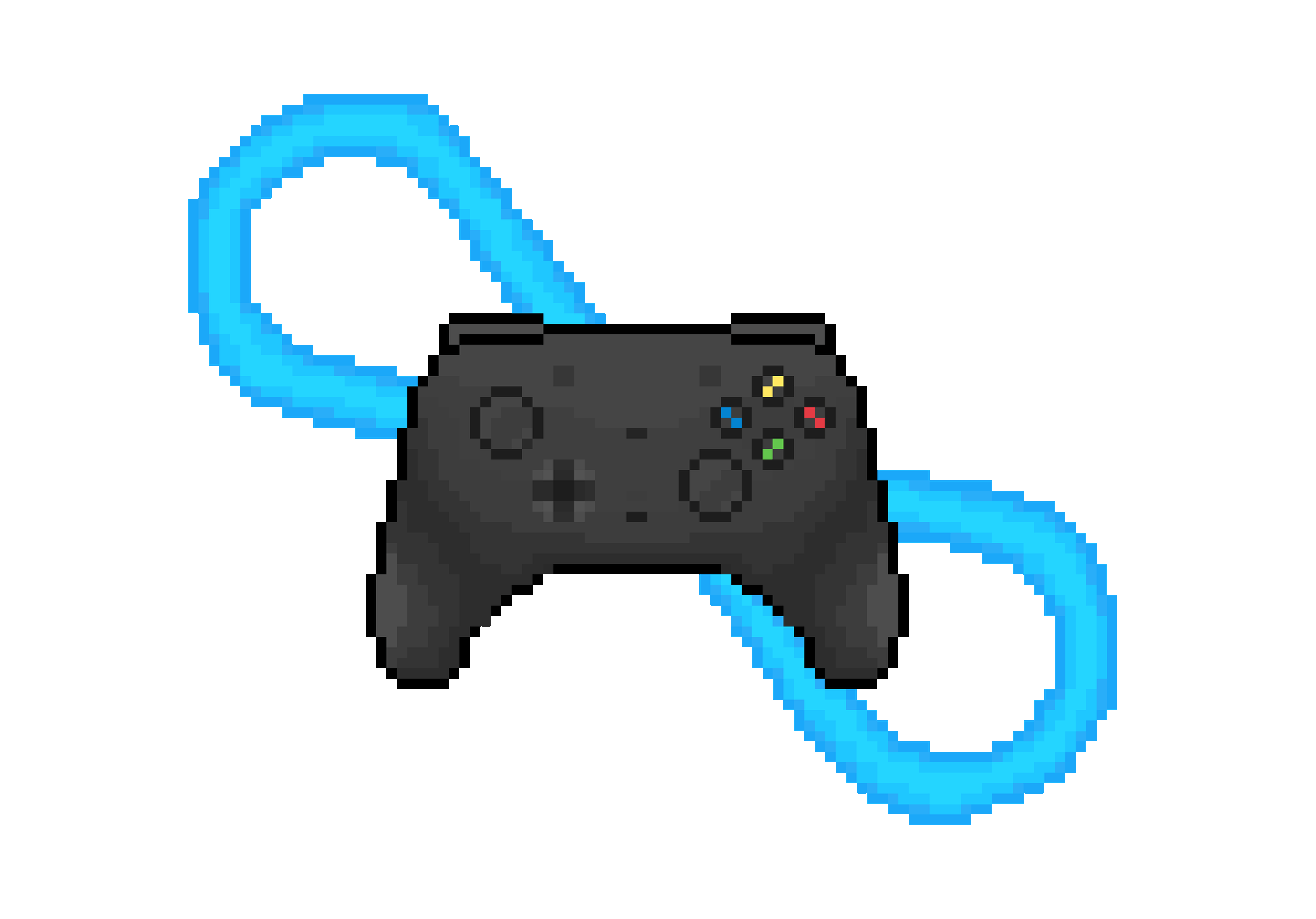🎮How I Gamified My Life to Enjoy Learning/Studying Part 1

My Video Game Addiction Story
As a kid, I was addicted to video games. Every day after school and extracurriculars I would run to my room and boot up the computer.
In the summer months, I could play for as much as seven hours a day. I lost track of time, immersing myself in rich video game worlds completely different from my own.
The real world just didn’t provide the carefully designed pleasures, the thrilling challenges, and the powerful social bonding I could get in virtual environments.
My addiction only became worse during the start of the COVID-19 pandemic. I was beginning my junior year of high school when our school went into hybrid mode. In the blink of an eye, I now had hours more time to play games.
So I did. My life became a cycle of eating, going to online classes, and playing video games. Until I hit a tipping point. I encountered what game scientist Jane McGonigal calls “gamer regret.” I was playing games so much I regretted what I was missing out on in the real world.
Gaming had become a form of escape.
I took a step back and asked myself a profound question. Would I be happy about how I was spending my time on my deathbed?
I knew then I needed to find some other more sustainable hobbies to hold my interest. But what? Creating YouTube videos? Reading books? Playing board games? Committing to my passion for tennis?
I started pursuing all of these. I felt alive. For the first time in a long time I was spending my time in a way I was proud of. I was learning new things, building skills, and building relationships with others in the real world.
When I started my first semester at Cornell University I had forgotten about my gaming addiction. It was a relic of the past and I was a changed person.
Yu-Kai Chou’s Video Game Addiction Story
Then I read a book called Actionable Gamification by Yu-Kai Chou. Chou had a remarkably similar story to me.
As a kid, Chou played Diablo 2 for thousands of hours with his friends. They were completely addicted, spending almost all their free time out of school grinding for gear, getting levels, and pursuing virtual rewards. Then one day in 2003, after grinding tens of hours for a particularly rare sword, Chou went to his friend's house to reveal his accomplishment. When he got there his buddies looked at him and said, “oh, you’re still playing that game? We don’t play Diablo 2 anymore.”
Chou was flabbergasted.
He realized if he moved on from Diablo 2, his thousands of hours would be wasted. All his progress was in the game world. They didn’t translate to real life.
He was disappointed in himself. How had he let a virtual game take his attention for thousands of hours? Then Chou had an epiphany: what if he could apply the game principles that made Diablo 2 so addicting to real life? What if he could make life a game he wanted to play?
He began playing and analyzing games and their designs for hundreds of hours. But this time he came with an analytical mindset.
After three years he developed Octalysis, an eight-step core drive framework that enables one to understand the core drives of human motivation.
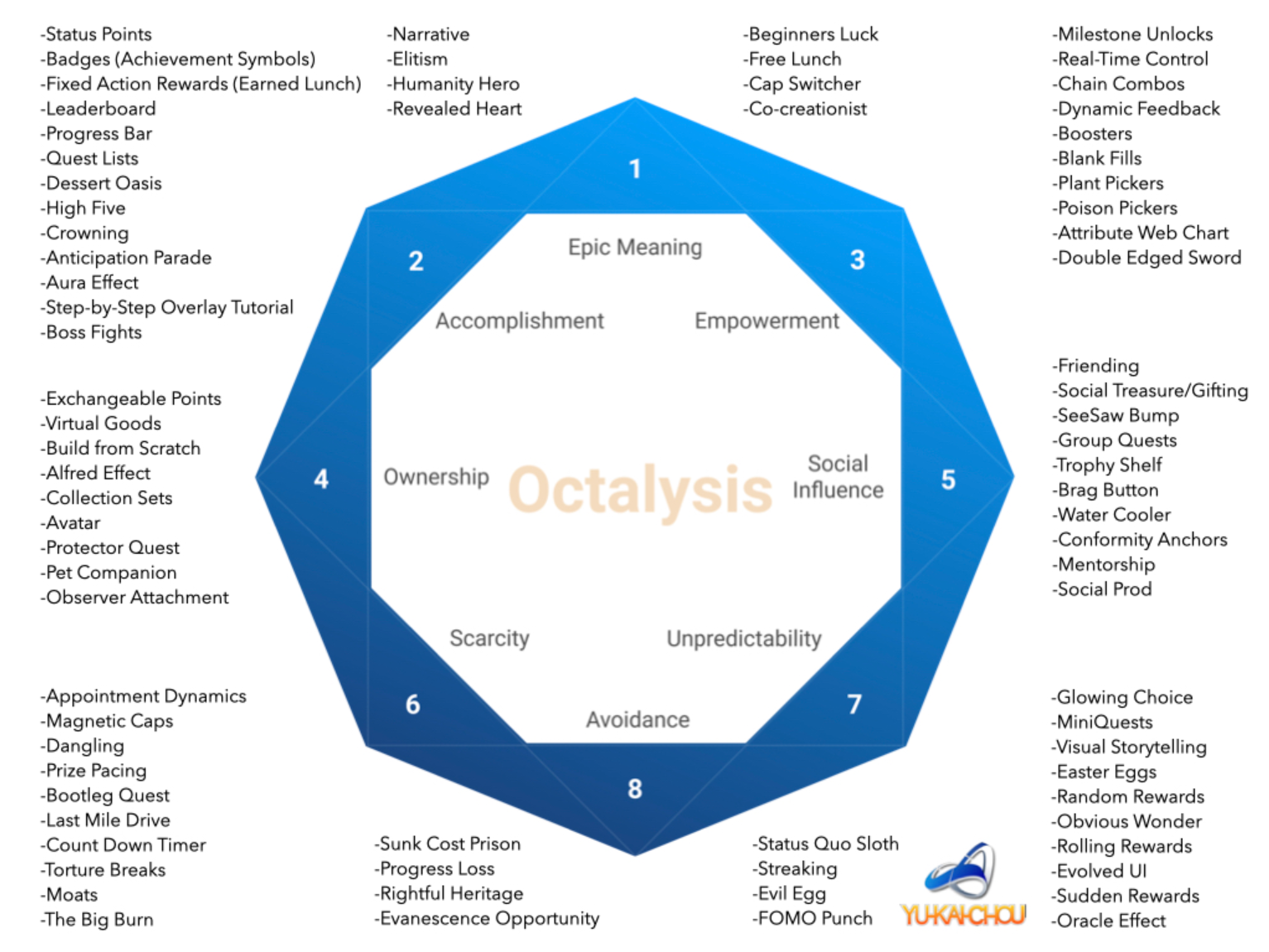
Chou defines the core drives in order as Epic Meaning, Accomplishment, Empowerment, Ownership, Social Influence, Scarcity, Unpredictability, and Avoidance.
These eight drives motivate everything we do in life. When none are activated, we have literally zero motivation to do anything.
Each of these core drives is taken advantage of by game designers using classic game design elements. You can see the large number of game elements listed out next to their associated core drives up above.
The Octalysis Framework fascinated me. It explained how the video games from my and Chou’s childhood gripped me so strongly.
But like Chou, it gave me another mission. I wanted to learn how I could apply the Octalysis Framework to make me want to do hard things. Hard things like starting that small business you always wanted to, finishing your Ph.D. thesis, or finally setting in stone a workout routine.
This process has a name: gamification. According to Chou, “gamification is the craft of deriving fun and engaging elements found typically in games and thoughtfully applying them to real-world productive activities.”
In the first part of this gamification series, I intend to summarize the Octalysis framework put forth in Chou’s book Actionable Gamification. After each core drive, I will give an example of a video game I was addicted to as a kid that particularly utilized that core drive.
In the second part of this series, I will discuss how we can use gamification to improve our lives. Finally, in the third part of this series, I will show you how I turned my life into a game using principles from the first two sections.
My hope is that by reading all three of these parts and Actionable Gamification, you will learn how you can gamify your own life as well.
This first part is by no means a comprehensive analysis of Actionable Gamification. The book is more than 500 pages long and chock full of insight. I recommend you check it out for yourself after reading this post.
I also want to make it clear that I don’t hate video games. They can be a healthy hobby if you play them in moderation. But because I played them for more than 20 hours a week, I started to experience gamer regret.
With that out of the way, let’s get into the core drives.
The Eight Core Drives
Core Drive 1: Epic Meaning and Calling
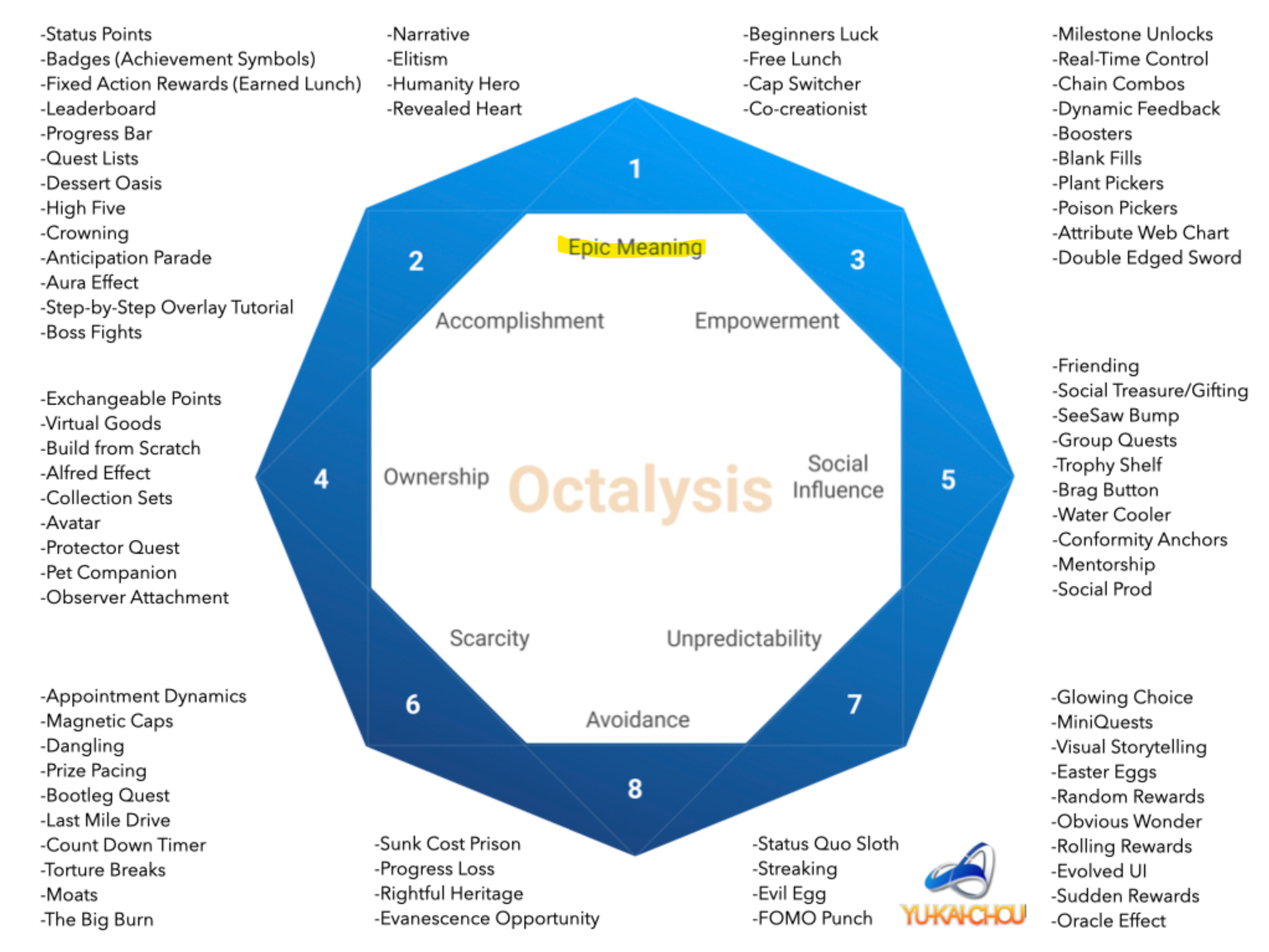
Chou states “Epic meaning and calling is the core drive activated when a person believes they are doing something greater than themselves or were ‘chosen’ to take that action.”
Humans have an insatiable need to feel like their actions mean something. Core drive 1 makes people take action not necessarily because it benefits them but because they see themselves as part of a greater story.
One game from my childhood that particularly targeted this core drive was Total War Warhammer 2.

This is a top-down strategy game where you are the ruler of a vast empire. You can choose to play as one of the many races and factions. The elegant yet arrogant High Elves, the stubborn and stout Dwarves, or the mysterious and mystical Lizardmen to name a few.
While some races are more prone to liking others, almost every race is unified in fighting against the Chaos Invasion from the North which threatens to destroy the entire world. Your goal (at least in the Mortal Empires mode) is to balance fighting other factions with handling the Chaos invasion threatening the world.
Playing this game made me feel epic—a gamer term for something awesome in proportion and often surprising. I was fighting not only for the fate of my faction but the fate of the entire world as well.
Battles were an awesome amalgamation of massive monsters clashing, infantry crashing together, and magic missiles sizzling through the sky. It was awe-inspiring.
Core Drive 2: Development and Accomplishment
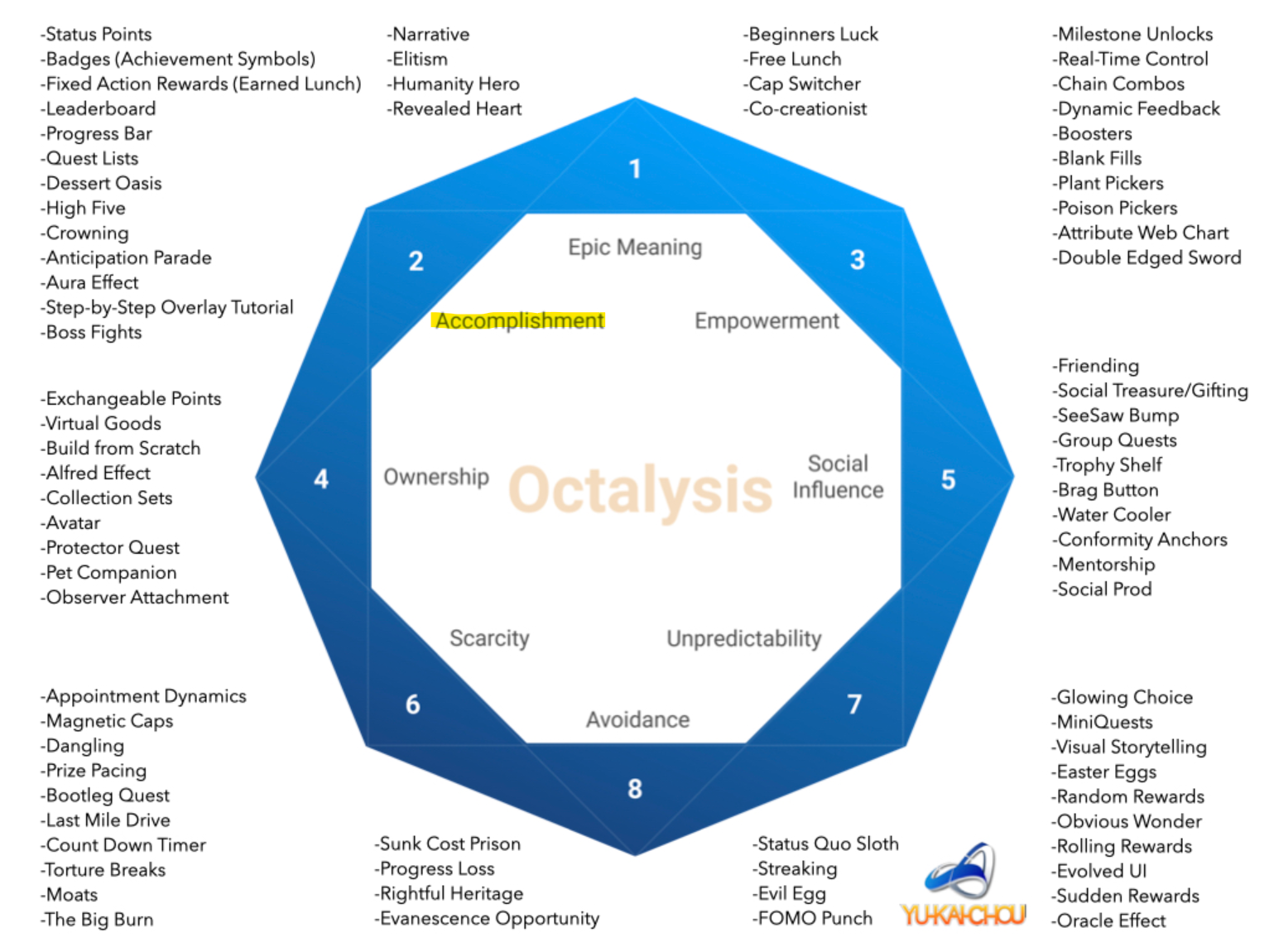
Chou states “Development & Accomplishment is our internal drive for making progress, developing skills, achieving mastery, and eventually overcoming challenges.”
All humans want to feel like their actions are leading somewhere. It’s satisfying to feel one's actions have a physical and measurable effect.
Most games target this drive through something called the “Win-State.” A Win-State is a scenario where the user has overcome some sort of challenge and reaped some reward. They feel a sense of progression and are often rewarded with points, a badge, or a new unlock.
Civilization Six targeted this core drive masterfully.

It’s another top-down strategy game where players take control of a civilization from history. They can play as Cleopatra of Egypt, Teddy Roosevelt of America, or Gilgamesh of Ancient Sumeria to name a few.
My favorite part of Civilization Six was the tech tree. The tech tree in Civilization Six is a chronological map of the technological innovations humans have made throughout history. As players progress through the tech tree, they unlock technologies that give access to new buildings, governments, units, and more.
This system made my actions feel like they meant something. The better I played, the faster I could progress through the tech tree to dominate the other civilizations. Tech tree improvements were even reflected in the game map itself, making every win even more satisfying. My cities looked different as I progressed from hunting and gathering to industrialization or the space age.
Core Drive 3: Empowerment of Creativity and Feedback
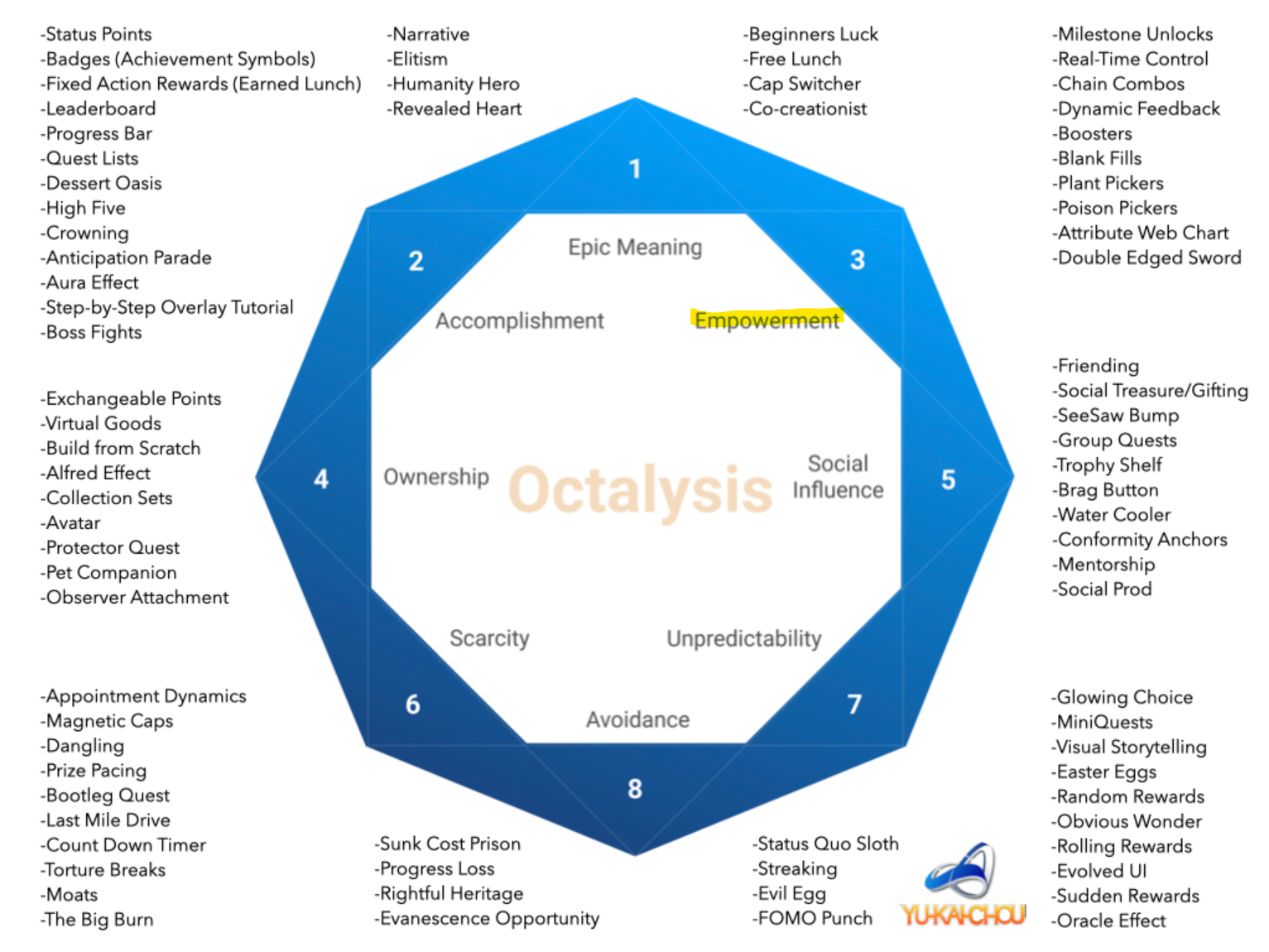
Chou states “Empowerment of Creativity & Feedback is expressed when users are engaged in a creative process where they repeatedly figure new things out and try different combinations.”
I believe every person has a craving to express creativity even if they aren’t an artist. Every job requires creativity of some sort—product design, YouTube video creation, or project management to name a few. in practically any job people can try new things and receive feedback on how their actions affected something in their environment.
Great games understand this fact and design games to have more than one standard way to “win” or have fun.
A classic game that effectively implements this core drive is Minecraft.
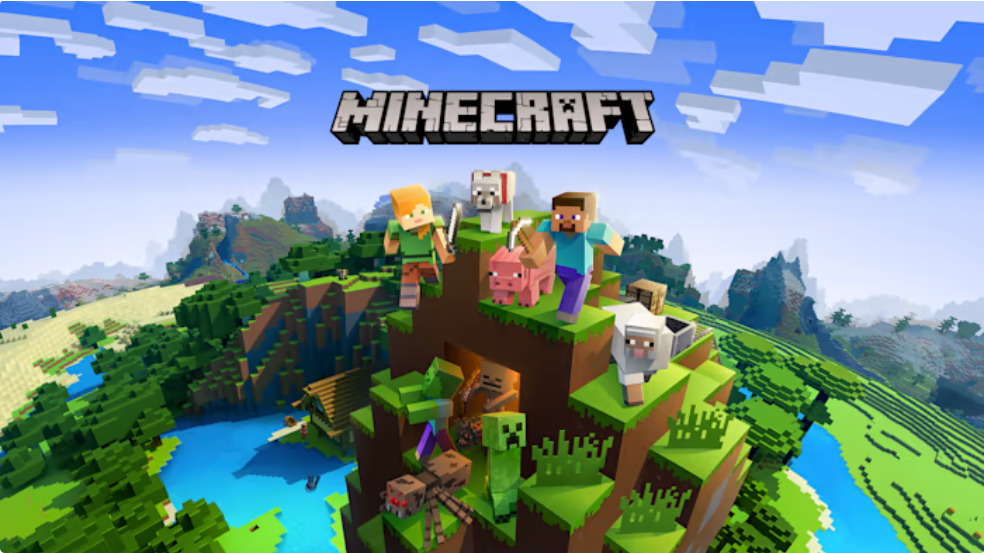
Minecraft can’t be summed up as a single game. That’s because the community can make any type of game they want to and play it inside of Minecraft.
This gives Minecraft practically infinite creative potential. You can play survival mode, creative mode, go through an adventure map, play party games with friends, and a whole bunch of other things.
But a large number of people find the most joy in building. There are hundreds of blocks to choose from in just the base game and no set rules. You can create whatever you want.
People have made some incredible things from simple farmhouses to models of the Star Wars Death Star and even entire real-life cities.
Core Drive 4: Ownership and Possession
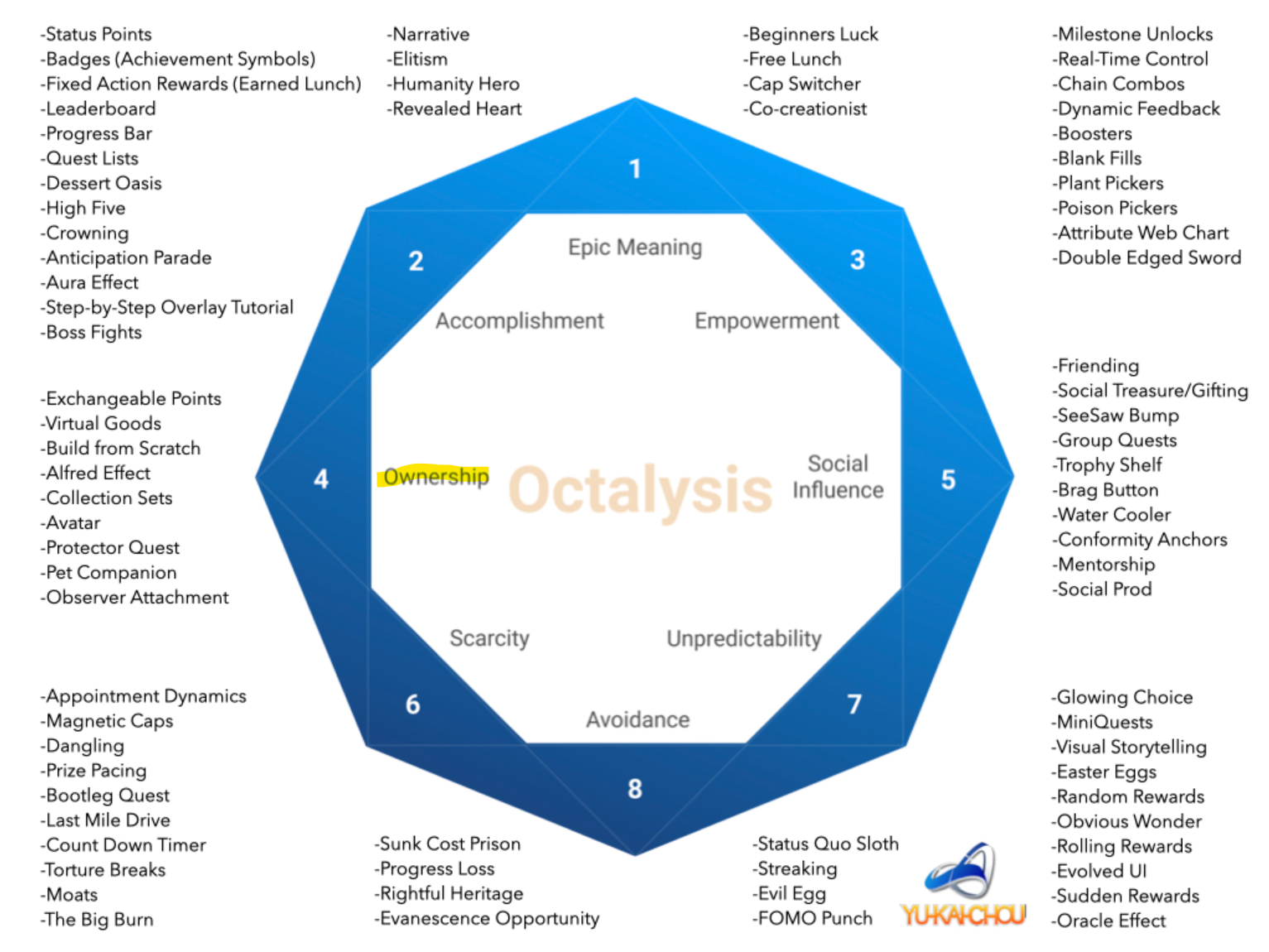
Chou states “Ownership & Possession is where users are motivated to own or control something.”
We value something greater after it is in our possession. It’s this psychological bias that leads people to collect and hoard.
But this core drive also makes us hold onto ideas. We all have a person in our life who stubbornly sticks to old habits and personality traits despite changing times.
League of Legends (LOL) particularly targets this core drive.
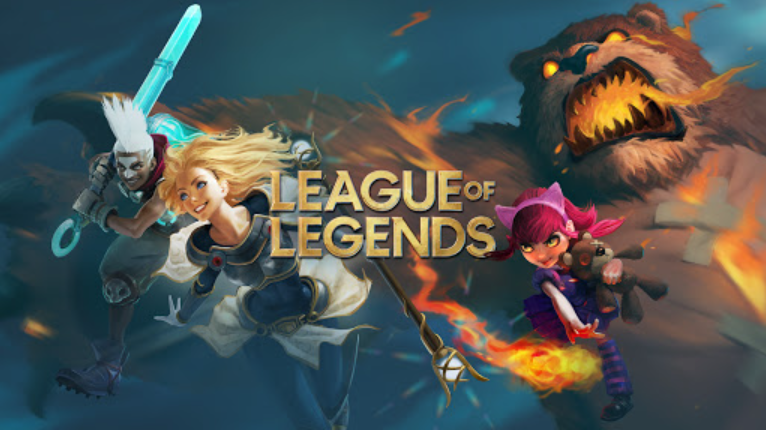
LOL is a multiplayer online battle arena game with over 140 champions to play. While the gameplay itself is invigorating, one of my favorite parts of playing League of Legends was growing my collection of 140 champions.
Every champion had their own playstyle, but also their own set of skins as well. It was these different skins that led me to make a series of what I can only describe as “regrettable purchase decisions.”
But hey, how many people can say they have both the white, black, and red Chromas of Swain’s Dragon Master skin?!
Core Drive 5: Social Influence and Relatedness
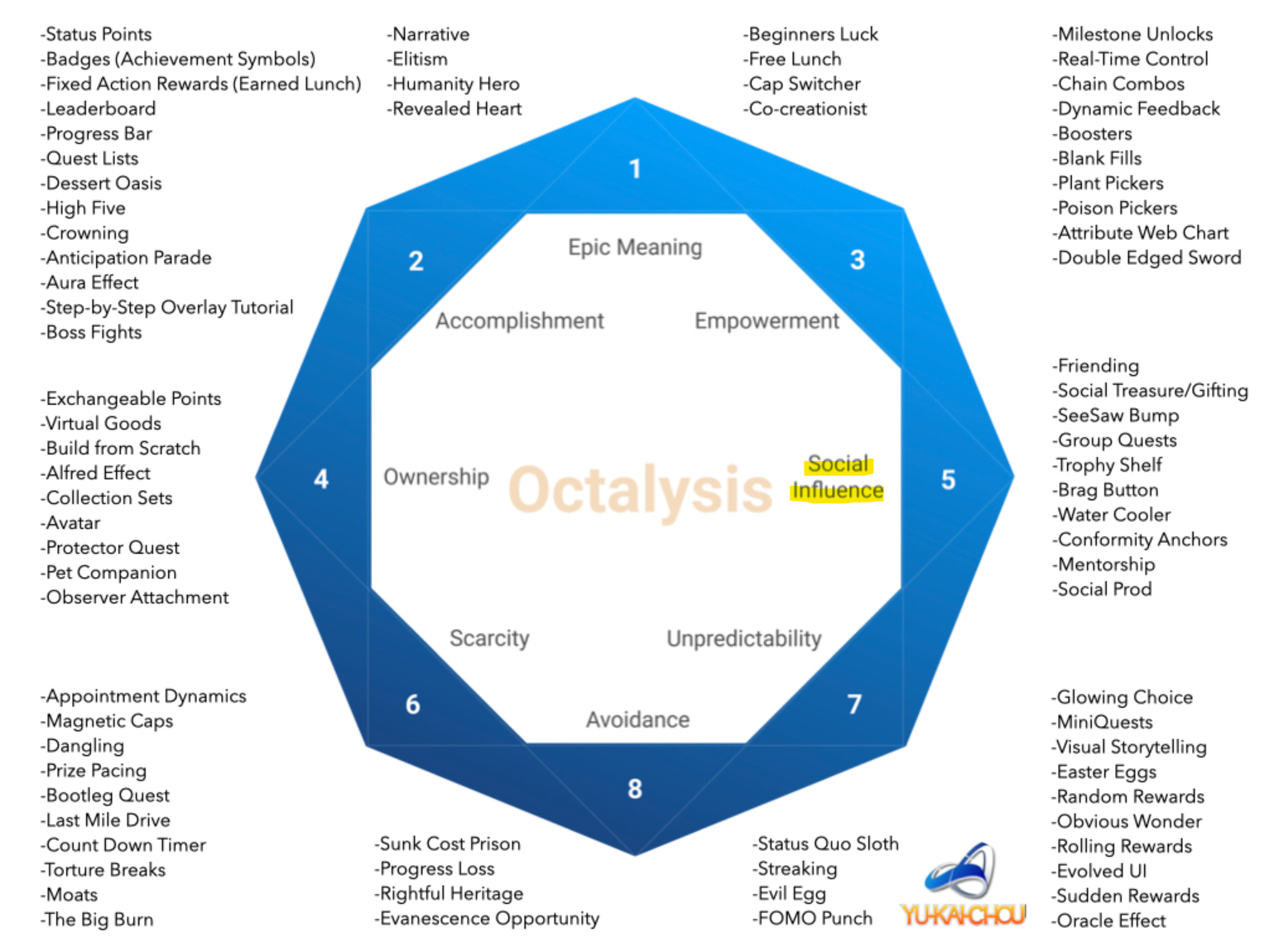
Chou states “Social Influence & Relatedness incorporates all the social elements that motivate people, including mentorship, social acceptance, social feedback, companionship, and even competition and envy.”
What we perceive as the social norm greatly influences our decisions and behavior, often more so than personal gains or moral standards. This has had extreme historical ramifications like the devastating acts performed by Nazi soldiers in World War 2. Some of them were just “following orders.”
Great games understand that humans have a craving for social interaction. We aren’t just driven to follow the crowd but also to be genuinely understood by other human beings.
One of the games which hit this core drive on the nail was Fortnite.
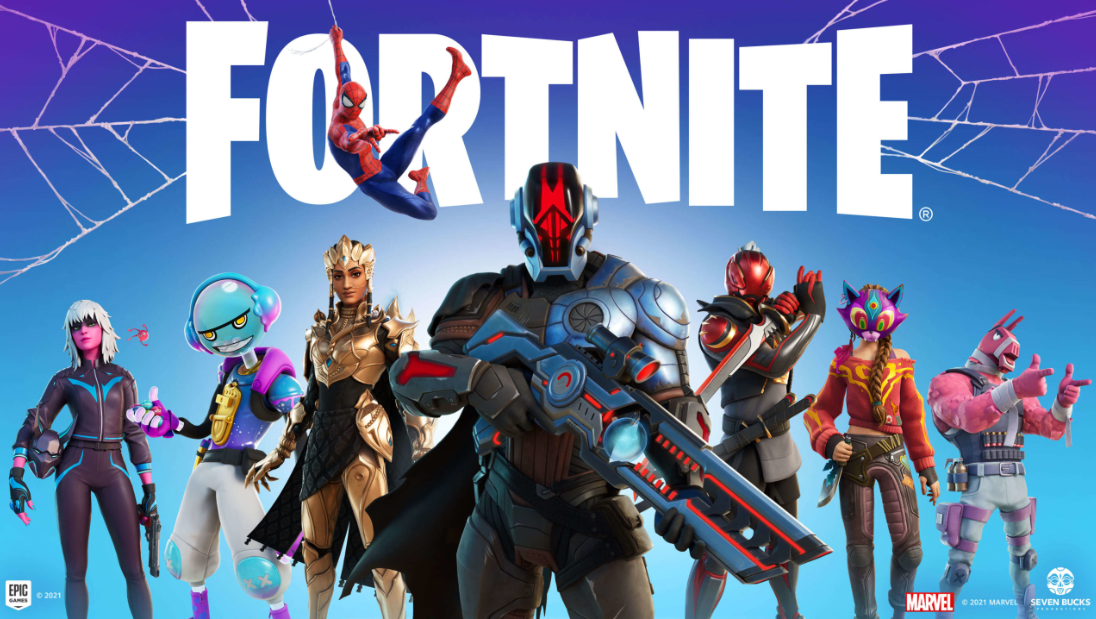
As of writing, Fortnite is the most popular of the Battle Royale genre, a type of game where hundreds of players fight to the death on one map until only one team or player is left standing.
Funnily enough, I don’t like Battle Royales that much. I’m more drawn to strategic games. But everyone in my school was playing the game. If I didn’t join the bandwagon I would have been a social outcast.
In addition, the competition between hundreds of other players to see who came out on top drove me to try my hardest in every match.
Core drive 5 made me play a game I didn’t even like. That’s the power of effectively using the Octalysis framework.
Core Drive 6: Scarcity and Impatience
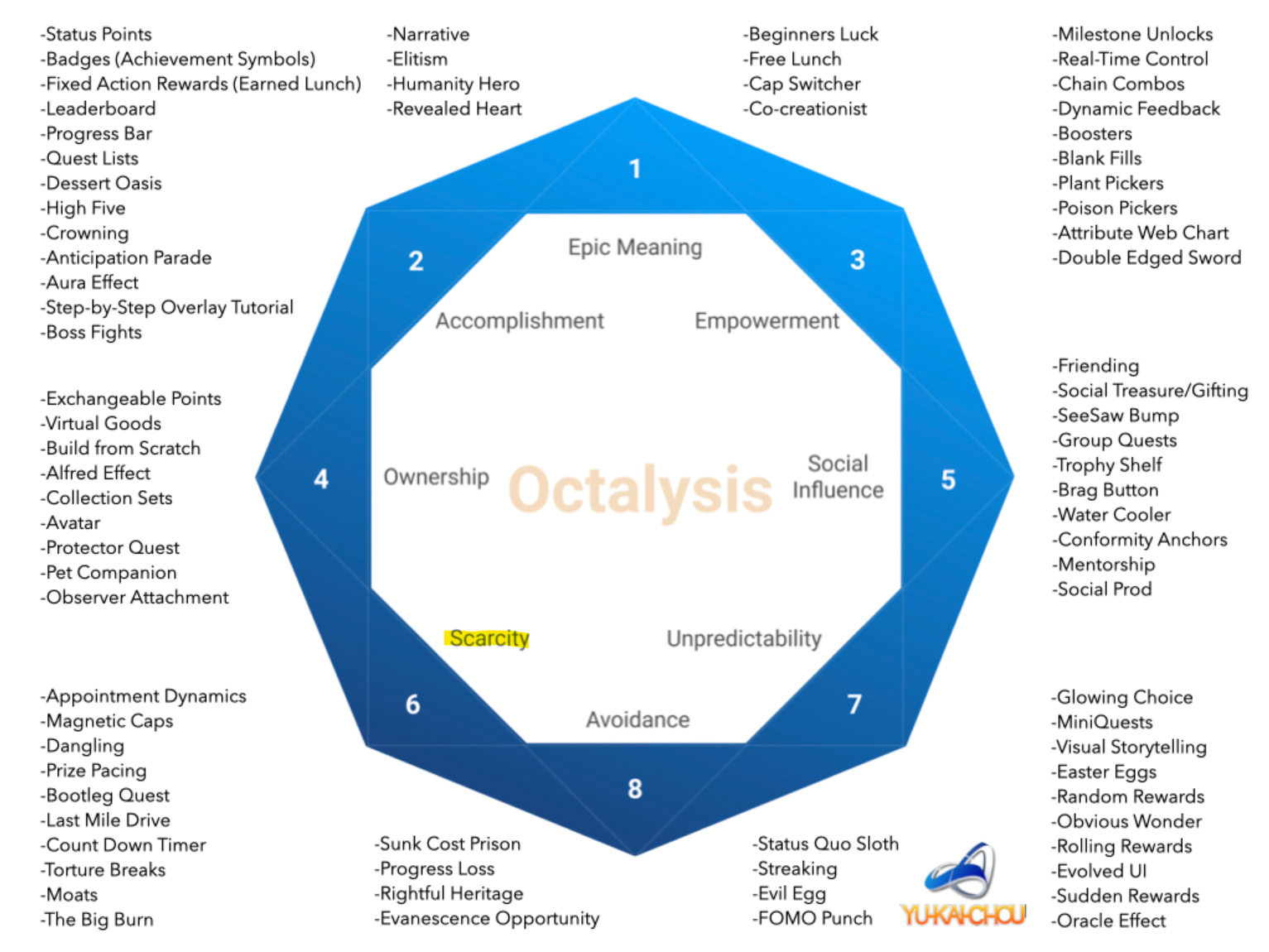
Chou states “Scarcity & Impatience is the Core Drive of wanting something simply because it is extremely rare, exclusive, or immediately unattainable.”
Countless studies have shown the more expensive something is the higher value we subjectively place on it. Ironically, this causes sales to sometimes increase with higher pricing.
This core drive also functions off of time as well. The less time we have to use a coupon or do something often the more we subjectively value that thing. The cult following of Starbucks Pumpkin Spice to see a real-life example.
Clash of Clans is a game that uses this core drive particularly effectively.
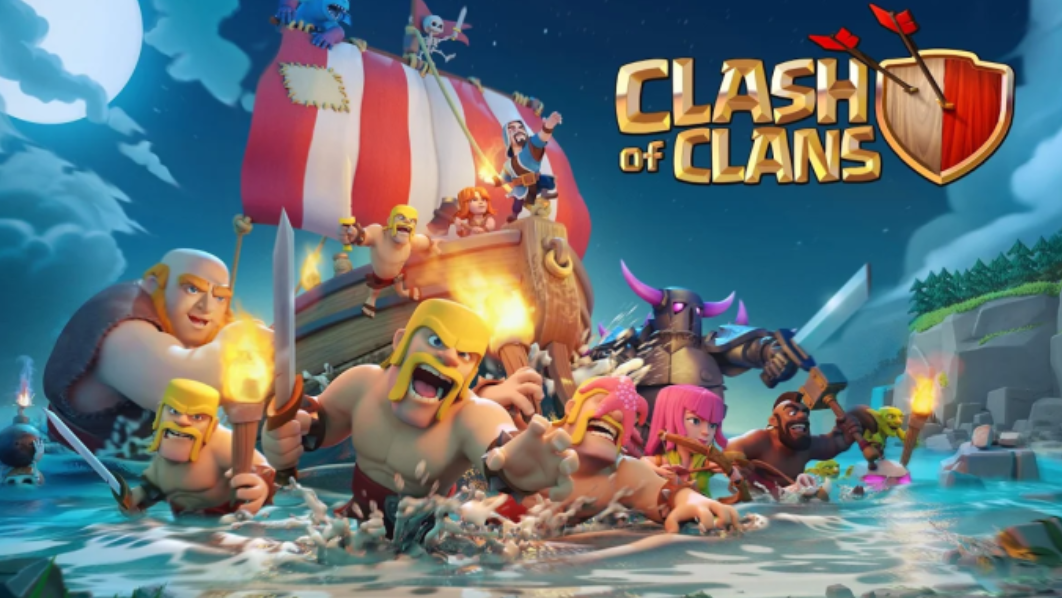
Clash of Clans is a mobile strategy game where you act as the leader of a village. Your goal is to grow your village by extracting resources and pillaging from other players.
But to attack other villages, you must wait for your troops to train. This often takes days for some of the higher-level troops like Pekkas.
Of course, you can also buy in-game resources to speed up this process. As a kid, my impatience got the better of me more than a few times and I paid real life money to go to battle a couple of hours faster.
Core Drive 7: Unpredictability and Curiosity
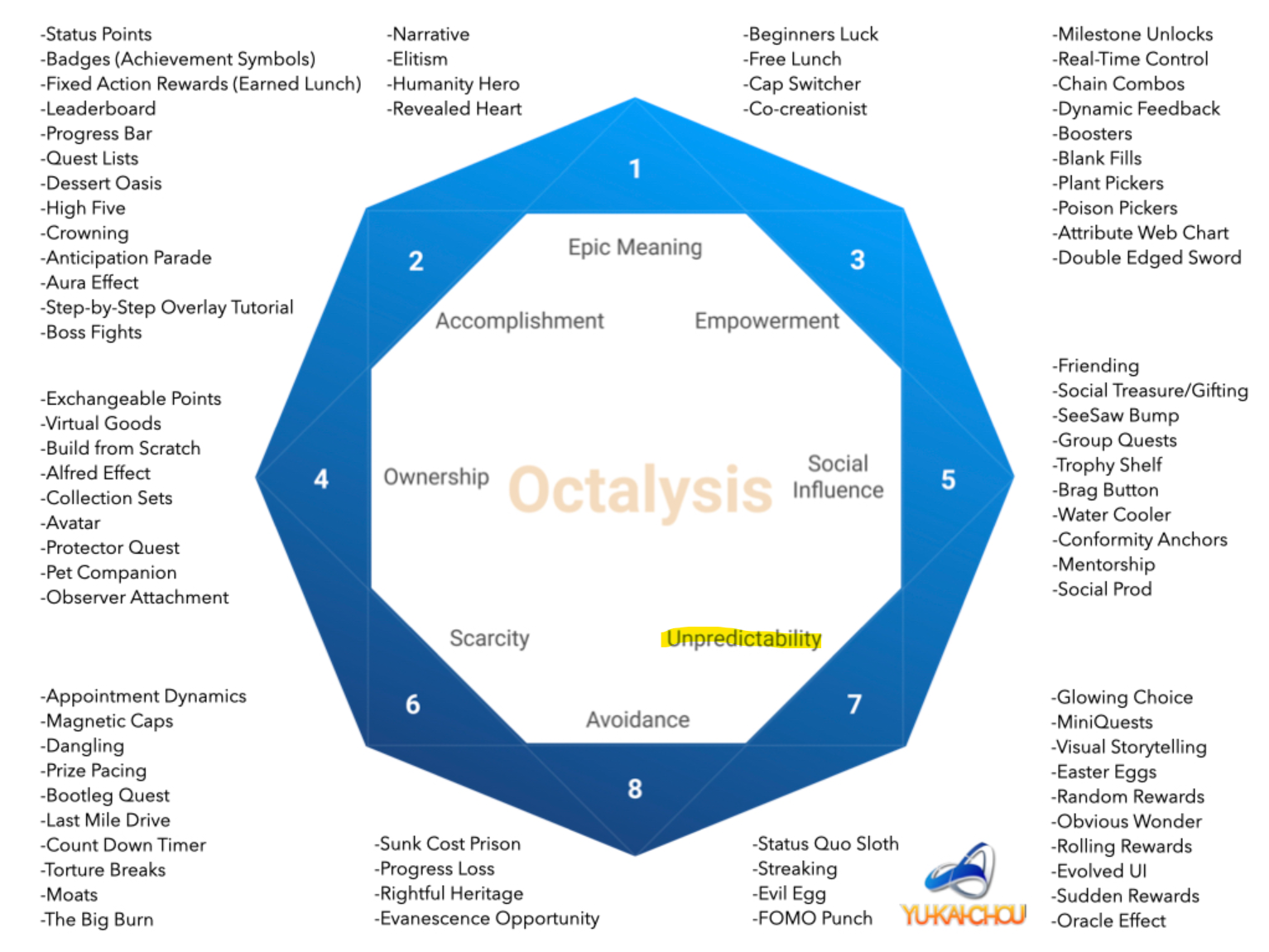
Chou states “Unpredictability is the Core Drive of constantly being engaged because you don’t know what is going to happen next.”
If there is nothing unexpected about a situation, our brain often delegates mental legwork to our subconscious so we can think about other things. When something does not fall into your regular pattern recognition cycles, however, our brain kicks into high gear and pays attention to the unexpected.
This is the main driver of curious acts. We come to an unpredictable situation (something like figuring out what in gods name they put inside Skippy peanut butter) to get more information.
When there is nothing unpredictable about a situation, however, we often get bored. Great game designers understand this and try to implement uncertainties into their game design.
Dead by Daylight is a great example.
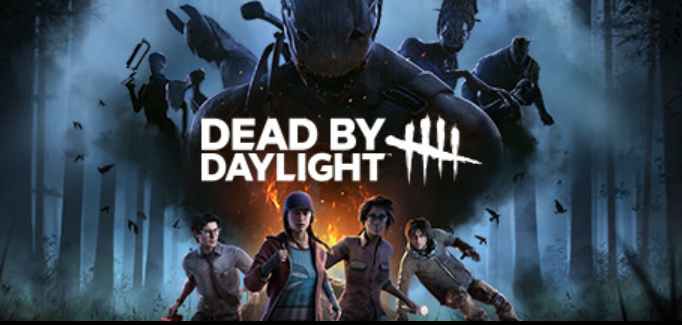
Dead by Daylight is a team based survival game where four players are put inside of a map with a single-player killer. The survivors have to repair five generators around the map to power the exit gates and escape the killer. The killer has to stop the players by literally sacrificing them on meat hooks to the god of the game, The Entity. I had weird tastes as a kid, I know.
As of writing, there are more than 31 playable survivors and 28 playable killers each with their own skills and playstyles. There are also 17 different playable maps with different layouts and generator placement.
These three different combinations lead to an insane amount of unpredictability in each map. I have more than 400 hours in this game alone and it’s all because not one match played out the exact same way.
Every game I know I will have to be on my toes. There will be a different map, killer, and survivor mix in every game.
Core Drive 8: Loss and Avoidance
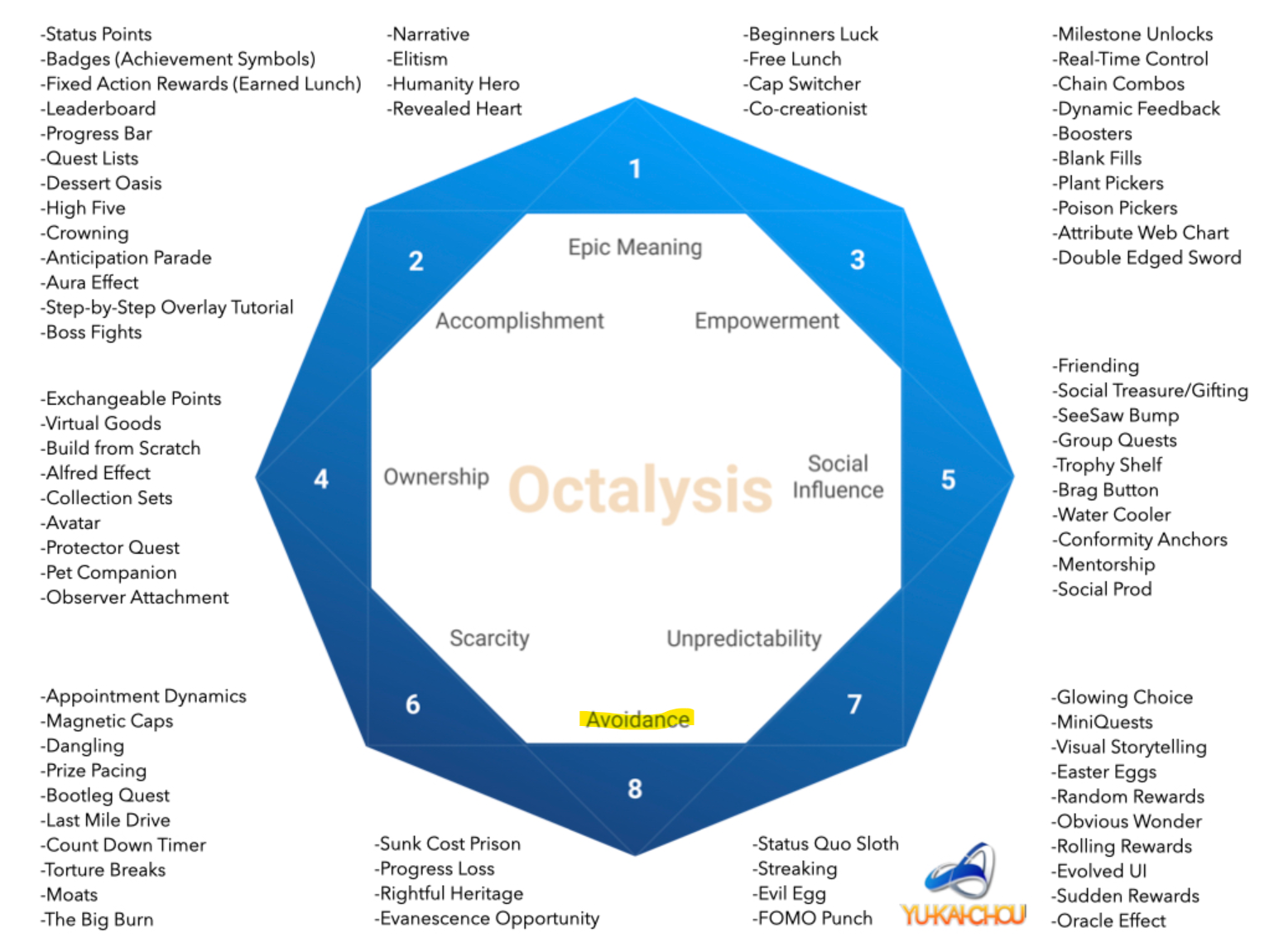
Chou states “Loss and Avoidance is the motivation to avoid something negative from happening. On a small scale, it could be to avoid losing previous work or changing one’s behavior. On a larger scale, it could be to avoid admitting that everything you did up to this point was useless because you are now quitting.”
This core drive is bolstered by loss aversion, humans’ tendency to feel twice as much pain for losing something compared to the pleasure of gaining something of equal value. On a more insidious level, this core drive can also keep us playing a game even after we don’t enjoy it anymore because we don’t want to admit all of our time spent was wasted.
This is what happened to me playing Counter Strike Global Offensive.
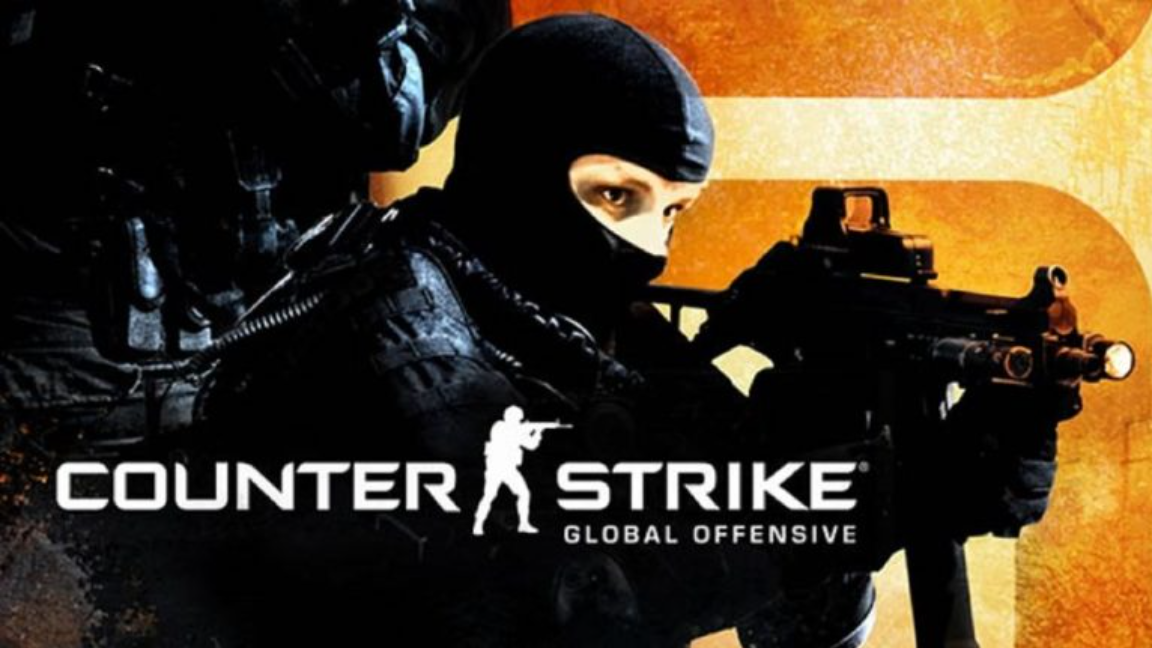
Counter Strike is a team-based first-person shooter game where players are split into two teams, terrorists or counter terrorists.
Counter terrorists must stop the terrorists from planting a bomb while terrorists try and bypass the counter-terrorists efforts and destroy the bomb site.
The mode I played most with friends was ranked. In ranked mode, every game you win or lose has a marked effect on your “rank” or standing in the game. As you get higher and higher in rank you play against better and better players, making it harder to win games. Every couple of months your rank resets but it also goes down from player inactivity.
This kept me playing in two ways. First, every game kept me locked in my seat because I wanted to avoid the pain of losing rank. Secondly, I kept playing even after I stopped enjoying the game because I didn’t want to lose my rank from inactivity.
Beyond the Eight Core Drives
Knowledge of the eight core drives gives great insight into human motivation both inside and outside video games.
But after finishing this initial framework, Chou realized the Octalysis framework needed a little more nuance. He understood while no one core drive is more powerful than the other, they all make us feel differently while under their influence.
As mentioned earlier, there is almost never a circumstance in which only one core drive is activated. In reality, these core drives mix and influence players in combination all the time. These different combinations make us feel differently. Because of this, he separated the eight Core Drives further into Right and Left Brain Core Drives as well as White Hat and Black Hat Core Drives.
Left and Right Brain Core Drives
Chou states the left brain core drives “involve tendencies related to logic, ownership, and analytical thought.”
They are expressed in the following three Core Drives: Core Drive 2: Development & Accomplishment Core Drive 4: Ownership & Possession Core Drive 6: Scarcity & Impatience.

On the other hand, the right brain core drives are “characterized by creativity, sociality, and curiosity.”
They are illustrated by the following: Core Drive 3: Empowerment of Creativity & Feedback Core Drive 5: Social Influence & Relatedness Core Drive 7: Unpredictability & Curiosity.

The major difference between the left brain and right brain core drives is the left brain core drives are result (goal) focused while the right brain core drives are process (journey) focused.
In other words, left brain core drives primarily motivate us through extrinsic rewards whereas right brain core drives primarily motivate us through intrinsic rewards.
This is essential to understand because, in the long term, a system driven by extrinsic motivation will fall apart. People leave because they don’t participate in the system for its own sake.
This explains why out of all the games mentioned earlier, the one I played the most was Minecraft. I have thousands of hours in that game.
Minecraft primarily targeted core drives three, five, and seven in its game design. It targeted core drive three through its practically infinite game types and the possibility of creative expression through building. It targeted core drive five because you could play with friends and other players on servers. And it targeted core drive seven because players could explore their curiosities by building new things or diving into new game types.
White Hat and Black Hat Core Drives
The eight core drives can also be split into white hat and black hat core drives.
White hat core drives are represented by the core drives at the top of the Octalysis Diagram: Core Drive 1: Epic Meaning & Calling, Core Drive 2: Development & Accomplishment, and Core Drive 3: Empowerment of Creativity & Feedback.

Black hat core drives are represented by the core drives at the bottom of the Octalysis diagram: Core Drive 6: Scarcity & Impatience, Core Drive 7: Unpredictability & Curiosity, and Core Drive 8: Loss & Avoidance.

What about core drives 4 and 5? Generally, Core Drive 4 and 5 have the duality of being able to be either white hat or black hat depending on the situation.
White hat core drives make us feel powerful, excited, and in control. Black hat core drives, however, make us feel obsessed, addicted, and anxious.
Generally, black hat core drives are incredibly motivating behaviors in the short term. They take advantage of our primal instincts, instincts to avoid things like wasting time, the unknown, and starvation. But in the long run, if not designed well, they will leave a bad taste in our mouths because we feel we have lost control of our own behaviors.
This is why games with the most long-term and passionate fanbase prioritize a mix of right brain and white hat core drives. Players are intrinsically motivated to keep playing and also feel powerful, excited, and in control the whole way through.
With these further distinctions, it’s clear the ideal game is one that prioritizes right brain core drives alongside white hat core drives. This way it maximizes intrinsic motivation alongside a feeling of control. Keep this essential realization in mind as you read through parts 2 and 3 of this series.
Learning to Gamify My Real Life
I don’t blame my childhood self for becoming so addicted to video games. Of course, I do wish I had done something else with my time and pursued activities that would help me in the real world.
But the games I played were specially designed to take advantage of humans’ core motivational drivers. I was as helpless as a kid in a candy store.
After learning about the Octalysis framework, I was ready to turn the tables. I was ready to start the process of using gamification to improve my life.
Check out part 2 to learn the first steps in how I began to do so!
Thanks to Astrid and Ian Helfant for the conversations which helped form this blog post.
